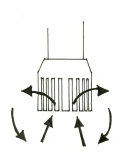PRO Scientific Oil and Extract Homogenizers
Blending, mixing, disrupting, emulsifying, dispersing & stirring
Mechanical homogenizing is used to emulsify immiscible liquids or liquids that are generally not soluble in one another or the process of uniformly dispersing solid particles throughout a liquid. This creation of uniform particle bandwidth in the submicron range, has immense benefits including; improved product stability, uniformity, consistency, viscosity, shelf life, improved flavor and color.
Click here to learn more about the full range of Rotor-Stator Homogenizers available from PRO Scientific including Package Kits, Hand-Held or Stand Mounted, Benchtop and Programmable Benchtop.
For application specific information, please visit our application page.
Mechanical Homogenizers
How does a PRO Scientific Homogenizer work?

The rotor-stator homogenizer or generator type homogenizer was first developed to make dispersions and emulsions, and most biological tissues are quickly and thoroughly homogenized with this apparatus. The appropriately sized cellular material is drawn up into the apparatus by a rapidly rotating rotor (blade) positioned within a static head or tube (stator) containing slots or holes. There the material is centrifugally thrown outward in a pump like fashion to exit through the slots or holes. Because the rotor (blade) turns at a very high rpm, the tissue is rapidly reduced in size by a combination of extreme turbulence, cavitation and scissor-like mechanical shearing occurring within the narrow gap between the rotor and the stator. Since most rotor-stator homogenizers have an open configuration, the product is repeatedly recirculated. The process is fast and depending on the toughness of the tissue sample, desired results will usually be obtained in 15-120 seconds. For the recovery of intracellular organelles or receptor site complexes, shorter times are used and the rotor speed is reduced.
Rotor-stator homogenizers - What affects my results?
The variables to be optimized for maximum efficiency are as follows:
-
Design and size of rotor stator (generator)
-
Rotor tip speed
-
Initial size of sample
-
Viscosity of medium
-
Time of processing or flow rate
-
Volume of medium and concentration of sample
-
Shape of vessel and positioning of rotor-stator
Rotor-stator homogenizers - The importance of the generator probe
With mechanical, rotor-stator homogenizing the most important component is the homogenizer probe also known as the generator. The size of this precision crafter component can vary from the diameter of a pencil for 0.01-10ml sample volumes to much larger units having batch capacities up to 19,000 liters or, for in-line units, capabilities of 68,000 liters/hr. Rotor speeds vary from 3,000 rpm for large units to 8,000-60,000 rpm for the smaller units. In principle, the rotor speed of the homogenizer should be doubled for each halving of the rotor diameter. It is not the rpm's of the motor but the tip velocity of the rotor that is the important operating parameter. Other factors such as rotor-stator design, which there are many, materials used in construction, and ease of leaning are also important factors to consider in selecting a rotor stator homogenizer.
PRO Scientific's homogenizers have the following tip speeds for the various rotor stator generators:
|
Generator |
Maximum Speed |
11p Speed (Meters/second) |
|
02-05075 |
28,000 rpm |
|
|
02-07095 |
28,000 rpm |
|
|
02-10115 |
28.000 rpm |
|
|
02-20200 |
28,000 rpm |
|
|
02-30200 |
28,000 rpm |
|
|
02-37200 |
20,000 rpm |
|
|
02-43200 |
20,000 rpm |
|
|
02-59200 |
20,000 rpm |
|
Rotor-stator homogenizers - What size homogenizer is right for me?
Laboratory size rotor-stator homogenizers process liquid samples in the 0.01 ml to a 20-liter range. The capacity of the rotor-stator should be matched to the viscosity and volume of the medium and with the type and amount of plant and animal tissue to be processed. The speed and efficiency of homogenization are greatly degraded by using too small a homogenizer, and the volume range over which a given homogenizer rotor stator size will function efficiently is only about 10 fold. Also, most of the laboratory-sized homogenizers function properly only with liquid samples in the low to medium viscosity range (<10,000 cps). This must be balanced against the practical observation that concentrated samples, by colliding more frequently, are broken up more rapidly. Higher viscosity samples can be processed but require specially shaped homogenization vessels or unique rotor-stator configurations. The size of the sample prior to processing with the homogenizer must be small enough to be drawn inside the stator. Therefore, samples often must be pre-chopped, cut or fragmented.
Rotor-stator homogenizers - Special homogenizing concerns.
Foaming and aerosols can be a problem with some models of rotor-stator homogenizers but PRO Scientific has taken steps to address both concerns. PRO Scientific Generator Probes are designed to be anti-foaming. Additional steps can be taken for efficient homogenizing including; keeping the tip of the homogenizer well submerged within the media and the use of properly sized vessels. Square-shaped or fluted vessels give better results than round vessels and it is also beneficial to hold the immersed tip off center. Aerosols can be minimized by using covered vessels. PRO Scientific offers a complete line of Safety Sealed chambers which eliminate the aerosol problem.

Related Links
- What questions should you ask when choosing a homogenizer?
- Tissue Tearor, cell lysor, disperser, high shear mixer - what's the difference and why do I need it?
- Homogenizer Selection Guide
- Homogenizer Package/Kit Selection Guide
- Learn more about the PRO Generator Probes
- Evolving Products in the Homogenizing Field
- Learn the best questions to ask when choosing a tissue homogenizer
- Need help selecting a homogenizer? Visit our choosing a lab homogenizer page.
- Request a quote


